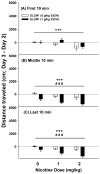Accentuating effects of nicotine on ethanol response in mice with high genetic predisposition to ethanol-induced locomotor stimulation
- PMID: 22795175
- PMCID: PMC3505243
- DOI: 10.1016/j.drugalcdep.2012.06.015
Accentuating effects of nicotine on ethanol response in mice with high genetic predisposition to ethanol-induced locomotor stimulation
Abstract
Background: Co-morbid use of nicotine-containing tobacco products and alcohol is prevalent in alcohol dependent individuals. Common genetic factors could influence initial sensitivity to the independent or interactive effects of these drugs and play a role in their co-abuse.
Methods: Locomotor sensitivity to nicotine and ethanol, alone and in combination, was assessed in mice bred for high (FAST) and low (SLOW) sensitivity to the locomotor stimulant effects of ethanol and in an inbred strain of mouse (DBA/2J) that has been shown to have extreme sensitivity to ethanol-induced stimulation in comparison to other strains.
Results: The effects of nicotine and ethanol, alone and in combination, were dependent on genotype. In FAST and DBA/2J mice that show high sensitivity to ethanol-induced stimulation, nicotine accentuated the locomotor stimulant response to ethanol. This effect was not found in SLOW mice that are not stimulated by ethanol alone.
Conclusions: These data indicate that genes underlying differential sensitivity to the stimulant effects of ethanol alone also influence sensitivity to nicotine in combination with ethanol. Sensitivity to the stimulant effects of nicotine alone does not appear to predict the response to the drug combination, as FAST mice are sensitive to nicotine-induced stimulation, whereas SLOW and DBA/2J mice are not. The combination of nicotine and ethanol may have genotype-dependent effects that could impact co-abuse liability.
Published by Elsevier Ireland Ltd.
Conflict of interest statement
No conflict declared
Figures






Similar articles
-
Effects of nicotine on ethanol-induced locomotor sensitization: A model of neuroadaptation.Behav Brain Res. 2015 Jul 15;288:26-32. doi: 10.1016/j.bbr.2015.03.066. Epub 2015 Apr 6. Behav Brain Res. 2015. PMID: 25857831 Free PMC article.
-
Role of genotype in the development of locomotor sensitization to alcohol in adult and adolescent mice: comparison of the DBA/2J and C57BL/6J inbred mouse strains.Alcohol Clin Exp Res. 2011 Jul;35(7):1351-60. doi: 10.1111/j.1530-0277.2011.01471.x. Epub 2011 Mar 15. Alcohol Clin Exp Res. 2011. PMID: 21410489 Free PMC article.
-
Reverse selection for differential response to the locomotor stimulant effects of ethanol provides evidence for pleiotropic genetic influence on locomotor response to other drugs of abuse.Alcohol Clin Exp Res. 2003 Oct;27(10):1535-47. doi: 10.1097/01.ALC.0000091226.18969.B9. Alcohol Clin Exp Res. 2003. PMID: 14574223
-
Nicotine enhances the locomotor stimulating but not the conditioned rewarding effect of ethanol in DBA/2J mice.Alcohol Clin Exp Res. 2015 Jan;39(1):64-72. doi: 10.1111/acer.12590. Alcohol Clin Exp Res. 2015. PMID: 25623407 Free PMC article.
-
Use of genetically distinct mouse populations to explore ethanol reinforcement.Alcohol Alcohol Suppl. 1993;2:451-5. Alcohol Alcohol Suppl. 1993. PMID: 7748338 Review.
Cited by
-
Nicotine affects ethanol-conditioned taste, but not place, aversion in a simultaneous conditioning procedure.Alcohol. 2018 Sep;71:47-55. doi: 10.1016/j.alcohol.2018.02.005. Epub 2018 Mar 2. Alcohol. 2018. PMID: 30029019 Free PMC article.
-
Effect of nucleus accumbens shell infusions of ganaxolone or gaboxadol on ethanol consumption in mice.Psychopharmacology (Berl). 2015 Apr;232(8):1415-26. doi: 10.1007/s00213-014-3777-x. Epub 2014 Oct 25. Psychopharmacology (Berl). 2015. PMID: 25342197 Free PMC article.
-
Differences in the reinstatement of ethanol seeking with ganaxolone and gaboxadol.Neuroscience. 2014 Jul 11;272:180-7. doi: 10.1016/j.neuroscience.2014.04.065. Epub 2014 May 9. Neuroscience. 2014. PMID: 24814021 Free PMC article.
-
Unique genetic factors influence sensitivity to the rewarding and aversive effects of methamphetamine versus cocaine.Behav Brain Res. 2013 Nov 1;256:420-7. doi: 10.1016/j.bbr.2013.08.035. Epub 2013 Aug 28. Behav Brain Res. 2013. PMID: 23994231 Free PMC article.
-
Young adults report increased pleasure from using e-cigarettes and smoking tobacco cigarettes when drinking alcohol.Addict Behav. 2019 Jun;93:135-140. doi: 10.1016/j.addbeh.2019.01.011. Epub 2019 Jan 16. Addict Behav. 2019. PMID: 30710807 Free PMC article.
References
-
- Adir J, Wildfeuer W, Miller RP. Effect of ethanol pretreatment on the pharmacokinetics of nicotine in rats. J Pharmacol Exp Ther. 1980;212:274–279. - PubMed
-
- Anderson SM, McClearn GE. Ethanol consumption: selective breeding in mice. Behav Genet. 1981;11:291–301. - PubMed
-
- Bachtell RK, Ryabinin AE. Interactive effects of nicotine and alcohol co-administration on expression of inducible transcription factors in mouse brain. Neuroscience. 2001;103:941–954. - PubMed
-
- Batra V, Patkar AA, Berrettini WH, Weinstein SP, Leone FT. The genetic determinants of smoking. Chest. 2003;123:1730–1739. - PubMed
Publication types
MeSH terms
Substances
Grants and funding
LinkOut - more resources
Full Text Sources
Other Literature Sources

